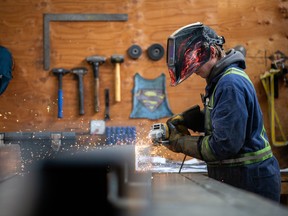NGen has launched initiative to educate young Canadians on the sector and showcase the wealth of opportunities available
Article content
“Out-of-date” is rarely associated with the young — except, it turns out, when they’re thinking about the manufacturing sector.
Advertisement
This advertisement has not loaded yet, but your article continues below.
Article content
Research by Next Generation Manufacturing Canada (NGen), the advanced manufacturing supercluster that is part of the federal government’s Innovation Superclusters Initiative, shows that many young people are as much as 40 to 50 years behind the times in their ideas about manufacturing. “Repetitive,” “boring,” “dirty” and “dangerous” are some of the terms they use to describe their views.
“That’s really too bad because the face of advanced manufacturing, which uses innovative technologies and techniques to make things, is so significantly different from these images,” said Linda Hasenfratz, chief executive of Guelph-based Linamar Corporation, Canada’s second-largest auto parts manufacturer. “Nowadays, it’s more about tech and innovation than anything else.”
Advertisement
This advertisement has not loaded yet, but your article continues below.
Article content
That’s reflected in the tools of the trade, many of which were the stuff of science-fiction just a few decades ago: computer and laser-guided systems, routed wirelessly to the Internet; 3D printers; digital twins; robotics; virtual and augmented reality; artificial intelligence devices that learn on the fly; and the “industrial internet of things” that links software systems and devices such as sensors, cameras and machines to the web, making them “smart.”
Still, 25 per cent of manufacturing workers are due to retire by 2030 and it’s unclear who will replace them: currently, individuals under the age of 25 comprise only six per cent of the sector’s workforce.

To address that shortfall, NGen has launched a youth initiative, Careers of The Future.ca, to envision “dynamic, innovative and fulfilling” careers in advanced manufacturing. The initiative is aimed at educating young Canadians on the sector, showcasing the wealth of opportunities available, and providing advice on how to kick-start career journeys.
Advertisement
This advertisement has not loaded yet, but your article continues below.
Article content
“Manufacturing has evolved, but perceptions of the industry have not,” said Jason Myers, NGen’s CEO. “Much of the sector has been high-tech for a long time, but media are still representing the industry with smokestacks belting out emissions.”
In truth, however, in many cases and even in the most tradition-bound industry, they aren’t. Hamilton-based ArcelorMittal Dofasco, for example, is working to digitize steel production, which will reduce energy requirements, minimize wasted raw materials and cut GHG emissions by more than 2,500 tonnes per year.
Government policy, Myers adds, is also behind the times.
“Governments are still making assumptions and collecting statistics based in the sixties and seventies,” he said. “They don’t take into account how important manufacturing is to the economy, the links the sector has to business services, and the technologies that revolve around the industry.”
Advertisement
This advertisement has not loaded yet, but your article continues below.
Article content
The sector’s “industrial revolution,” as Myers calls it, came about 30 years ago, when technology-driven automation emerged.
It’s a natural fit for young people to come and be part of these solutions that make more sustainable things for the future
Linda Hasenfratz
“Where Canadian companies really excel in creating value for customers is in developing unique engineering solutions by making smart products that provide platforms for all sorts of services,” Myers said. “So what we have now is high-tech, clean production facilities featuring people who are solving problems and doing work that has become much more customized.”
Indeed, the pandemic has highlighted the importance of “made-in-Canada” solutions even as demand has surged for clean products and game-changing technologies to address the biggest challenges facing society, including climate change.
Advertisement
This advertisement has not loaded yet, but your article continues below.
Article content
“Young people who are design-oriented could have great engineering careers in the manufacturing sectors, and those who prefer to work with their hands can help fill the need for highly skilled tradespeople who can work with technology,” Myers said.
As Hasenfratz sees it, manufacturing companies are behind the development of many of the solutions to societal problems, including emissions reduction, renewable energy and biomedical disease protection.

“It’s a natural fit for young people to come and be part of these solutions that make more sustainable things for the future,” she said.
The challenge is to make manufacturing exciting to the next generation of workers.
“Most people under the age of 30 want to do things in a new way,” said Billy Rideout, chief executive of Exergy Solutions in Calgary, an energy and climate technology solution provider that is leading a project with Suncor Energy Inc. to develop cleaner additives and technologies that could cut energy and intensity emissions by as much as 30 per cent. “Old-schoolers are a little too slow to get into the next century, and therein lies the opportunity.”
Advertisement
This advertisement has not loaded yet, but your article continues below.
Article content
New technologies, Rideout maintains, are “enablers,” the best way to get young people to enter the workforce.
-

Green transition will upend labour force, starting with white-collar workers, RBC report says
-

Displaced oil and gas workers are joining Alberta’s tech sector in droves
-

‘Burning through staff’: Firms desperate to hire, retain workers turn to wage hikes, tech
-

Banks facing severe talent shortage, RBC chief executive says
“New tools, new rules, is something we’re fond of saying,” he adds.
By way of example, Rideout points to Suncor’s embrace of 3D printing and use of unique geometry to create, exotic energy-efficient materials that can stand the test of time.
“Virtual and augmented reality and 3D apply to virtually every project we’re doing at Suncor,” he said. “These technologies are accelerating the speed of project execution with the goal of achieving net zero by 2050.”
The challenge, then, is bringing the realities of advanced manufacturing home to the younger generation. NGen hopes its Careers of the Future.ca initiative is a step in that direction.
“We expected 50,000 engaged visits to our site this past summer,” Myers said. “But we got about 250,000.”
Financial Post
_____________________________________________________________
For more stories about the future of work, sign up for the FP Work newsletter.
______________________________________________________________
Advertisement
This advertisement has not loaded yet, but your article continues below.
Labour-hungry manufacturing sector has a message for young people: think sci-fi, not smokestacks
2022-02-18 14:38:14






